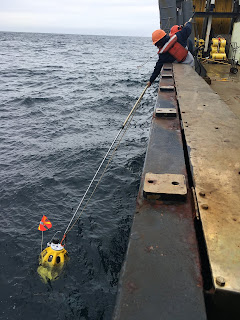Thank you thank you thank you

On June 1, we arrived in port in Kodiak, Alaska, marking the end of our expedition. Kodiak greeted us with spectacular vistas of mountains and lush green hills. It’s not called the Emerald Isle for nothing! Views of Kodiak on our way into port Despite a late departure and some rough weather, it was an enormously successful trip. We collected a suite of fabulous datasets that will help us understand the formation of this 6000-km-long chain of volcanos that have formed across the Pacific plate over the last 80 million years. Many mysteries remain about the water-covered parts of our planet, particularly in remote regions like our study area, despite the fact that they host truly gigantic structures. Jimmu Seamount is nearly as tall as Denali, the tallest mountain in North America, and much more massive! Comparison of bathymetry across Jimmu Seamount and elevation across Denali Collecting data that enables us to unr...


